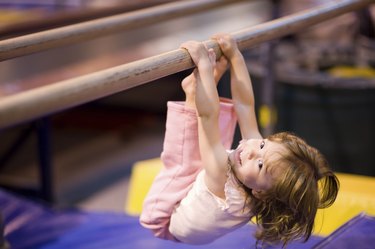
Children need exercise just as much as adults, so it's appropriate for them to go to the gym from about the age of 2 onward. The Center for Disease Control and Prevention, recommends children get at least one hour of exercise every day. Benefits of regular exercise for children include controlling stress, raising self-esteem, maintaining a healthy weight, building a healthy body and improved sleep. The type of activity a child does at the gym depends on his age and physical maturity.
Ages 2 to 3
Video of the Day
The gym can help your toddler improve her motor skills, through activities such as running and throwing. Toddler gym exercise classes are appropriate but should emphasize fun over structure and creativity over strict form. Observe preschool gym classes geared toward body awareness, while strengthening language skills, cooperation and observation skills. Young bones should not be stretched in a rigorous way as skeletons are still developing. Play with your child while at the gym using games such as tag or leap frog. As motor skills mature, games can become more complex incorporating movements such as running, jumping, skipping and tag. She may enjoy toddler adapted classes for swimming, T-ball, yoga and tumbling.
Video of the Day
Ages 4 to 5
As her motor skills mature, your child's gym classes can become more complex, incorporating movements such as running, jumping, skipping and tag. She may enjoy classes at the gym such as swimming, T-ball and tumbling. Gymnastics can be introduced, as long as the emphasis is still on fun and creativity, rather than a rigorous, structured fitness regime to further develop her motor skills, improving balance and coordination. Many gyms have T-ball classes, teaching the basics beginning at around age 4. According to the website T-Ball USA, T-ball is one of the first team sports most children learn. The game should serve as an introduction to the sport and teach basic skills.
Ages 6 to 12
An elementary school child starts to make more of her own decisions about how she wants to exercise. She may enjoy more organized gym sports meeting up to three times a week. She's ready to have gym classes extend beyond the basics during these years to help her develop her own style. Her gym activities can include yoga, rock climbing and more advanced gymnastic classes, as well as group activities such as softball, baseball, basketball, soccer, horseback riding and swimming.
Ages 13-18
Your teens begins to exercise in a highly structured manner, that will more closely resemble her exercise regime as an adult. Exercising gives your teen an alternative to sedentary activities such as video games, watching TV and surfing the Internet. He may choose either individual gym activities such as jogging, swimming or weightlifting or team sports such as football, basketball or wrestling.It's appropriate for him to begin weightlifting, if this peaks his interest. According to the website, kidshealth.org, once your child begins puberty, he has the hormones necessary to build muscle through formal resistance training such as weightlifting.